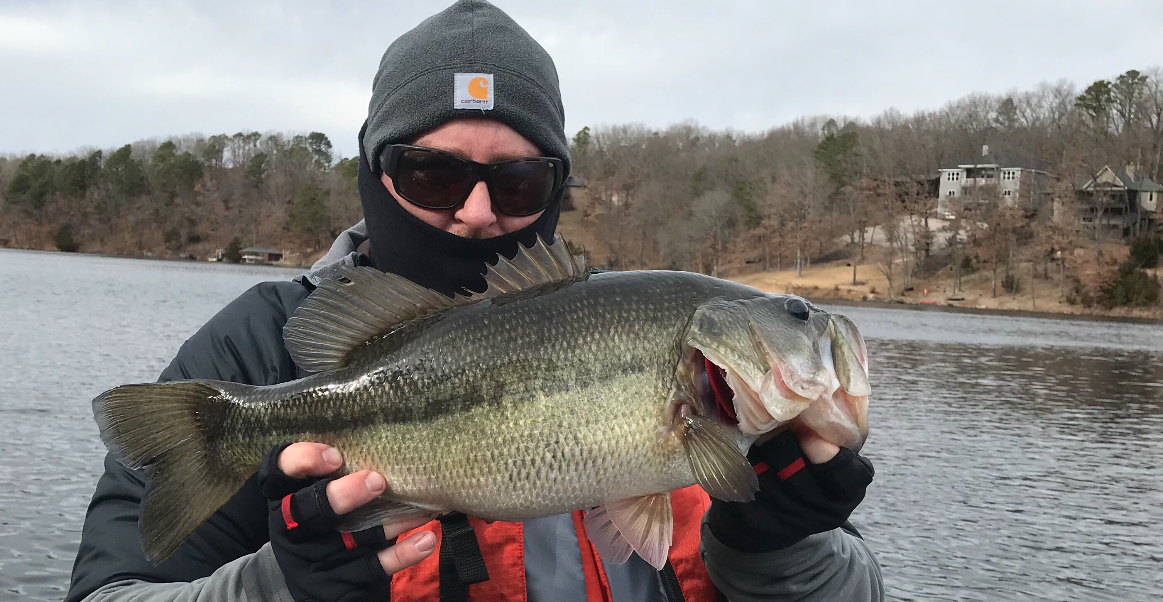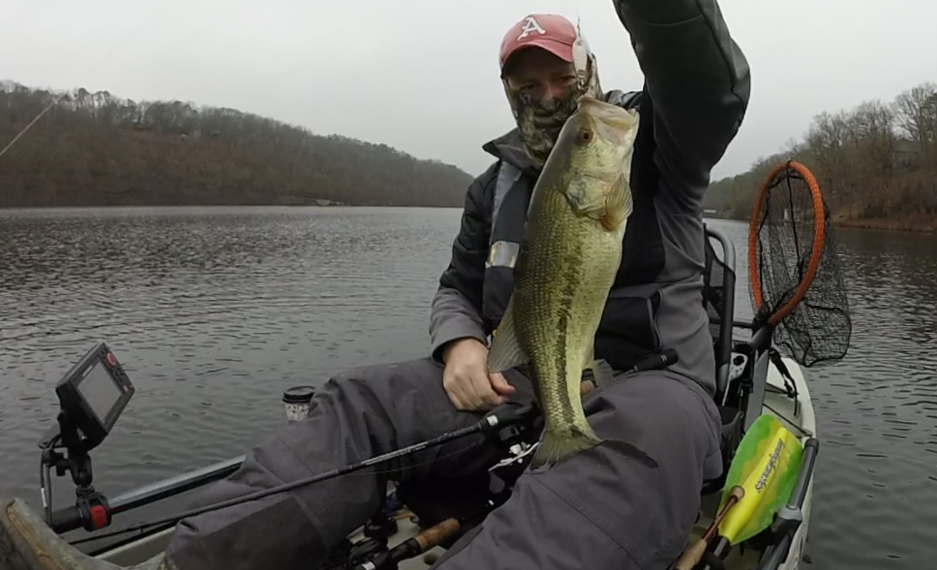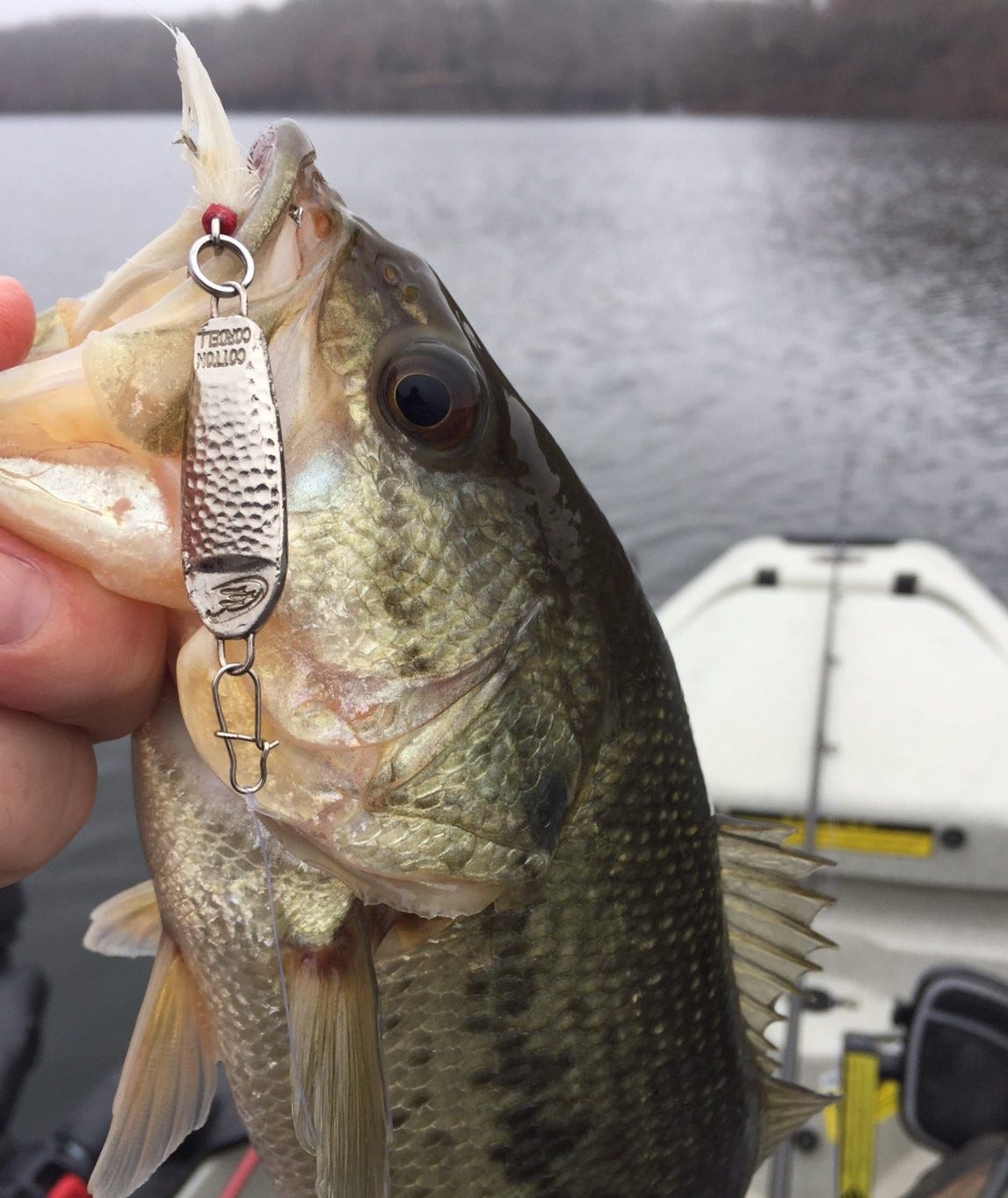- Dec 5, 2023
Jig a Spoon for Wintertime Bass
Jigging a spoon is a highly effective way to target bass throughout the cooler months. Learn how and where to vertical jig a spoon to catch more fish this winter.


When the leaves are gone, and the water grows cold, winter bass fishing can be a frustrating challenge or a bass bonanza. For us who like a good game of hide and seek, combined with catching a lot of bass in a hurry, jigging spoons can provide that winter bass bonanza. A jigging spoon can be used year-round anytime fish are deep or grouped up in schools, but the best and most productive season for a jigging spoon on a highland reservoir is winter, when the water temp is in the mid-40s or below.
Jigging a Spoon


Jigging a spoon is one of the oldest techniques for fishing vertically in deeper water. The simplicity of the lure and associated technique is one of the reasons it is among my favorite ways to catch bass.
In its simplest form, a jigging spoon is a small, elongated slab of metal with a hook on one end and a line tie on the other. The design allows the lure to flutter and wobble enticingly when lifted and dropped. The spoon shape contributes to the erratic and injured baitfish-like action that triggers predatory fish to strike.
Jigging spoons have been around for more than 100 years and have their roots in ice fishing, where an angler would drop straight down through the ice for perch, walleye, and other northern gamefish.
Spoons come in all sorts of colors, but I stick with the basics for bass. Generally, you don’t use a jigging spoon in dirty water, but if it is a bit dingy, or cloudy, a white or gold spoon is the way to go. If the water is clear or it is a partly sunny to sunny day, 90 percent of the time I reach for a chrome or silver color spoon. Of all the spoon options, the Cotton Cordell CC Spoon is my favorite when using silver or gold, while the War Eagle Jiggin Spoon is my choice when I want a white or a painted spoon, like the Purple Shad color.
As for weight, I believe you should use the lightest spoon you can get away with based on the depth you are fishing. Usually for me it will be a 1/4- or 3/8-ounce spoon for depths down to around 35 feet. Deeper than that, I’ll upsize a bit to a 1/2-ounce spoon. Occasionally, a bigger spoon is needed to get a bite, especially for working deeper or matching larger forage.
Notably, the CC Spoon recently went through a design change that is actually a return to its original shape. At one point, the shape of this iconic jigging spoon was altered slightly to make it a little less slender. It remained a great lure, and many anglers never knew it changed. However, avid CC Spoons repeatedly voiced a preference toward the original shape, enough so that Cotton Cordell decided to change it back. All sizes of the CC Spoon are now being produced only in the original design.
Choosing the Right Setup


Equipment and tackle needs for jigging a spoon are straightforward. I’ll almost always use a baitcastng reel with a fast retrieve ratio so I can quickly bring the spoon to the surface for my next cast or drop.
People may use different type of rod setups, but I favor a standard crankbait rod because the limber tip will allow the bass to get ahold of my spoon easier if I’m jerking it up. Once a fish is hooked, that rod has the perfect amount of flexibility for keeping the fish hooked on the small treble hook. Usually, once you get one hooked, it stays hooked.
Finally, I prefer to use a heavier line if I can get away with it. If the water is super clear, you may need to use a lighter line, even 8-pound test, but normally I’ll fish with 12-pound if I can. The heavier the line, the less you’ll suffer from line twist.
Fishing a Jigging Spoon


Fishing a jigging spoon is incredibly simple, and almost anyone can effectively fish a jigging spoon with just a little practice. The basic method of jigging a spoon is using an up and down motion at an appropriate depth to reach the fish you are targeting.
For bass you believe to be close to the bottom, simply position your boat or kayak over the target—whether it be fish, bait, or structure—drop the spoon straight down, let it reach the target depth, and then execute a rhythmic up and down jigging motion. After snapping the jig up and down a few times, reel up your spoon a turn or two of the reel handle and jig it some more.
Experimenting with the intensity of the rod snaps and the pause duration after the fall adds some nuance to the to the approach until you find the magic cadence.
Most bites occur during the fall, so pay attention if the line stops suddenly. You may have a fish on! Other times, when you snap the rod upwards, you feel a spongy weight on the line. Either way, don’t over-set the hook. Just snap it a bit harder upward and start reeling. Catching winter bass with jigging spoons is not just a fishing technique; it's a dance and a tease—a rhythm that, once mastered, lure a bass into taking the bait.
Finding Winter Bass


Placing the spoon in close vicinity of the bass is more than half the battle. These lethargic fish in winter won’t travel very far or very fast to feed. The goal is to drop this tasty looking bait right in front of or in close proximity to the fish. To do so, you most know where to start.
Depth of bass in the winter is going to vary greatly by fishery, but in the highland reservoirs I fish, I often find them in winter in the 30-40 foot range. In shallower lakes, they won’t be as deep, but often are in the deepest water available.
Bass suspend in winter over or near many types of cover and structure. Points, bluffs, drops, standing timber and treetops are all areas you should check. If you don’t have electronics, simply drop the spoon to the bottom or to a depth you want to try and jig it up and down. No bite? Reel it up a bit and jig it again. Doing this will help you find the right depth – when you catch a bass, that’s the depth you should fish the rest of that day. Also, because bass group up in winter, if you catch a bass in a spot, there are likely several more in that spot or nearby.
If you are using electronics and can see isolated or schooled up suspended bass, fishing a jigging spoon is even easier. Instead of starting at the bottom and working up, simply target the depth where you see the suspended fish or the school. Keep in mind, bass of similar sizes tend to school up, so if you are catching smaller fish, move on to another spot to search for bigger ones.
Jigging Spoon Modifications & Tips


Most of the time, the spoons are ready to go right out of the package. However, I sometimes do a few things to prepare for a hassle-free day on the water or to provide a different look from the standard spoon.
When jigging a spoon, it flutters and has a spinning, twisting motion that is irresistible to bass but can put a twist in your line. To counteract the line-twisting action induced by the falling spoon, incorporating a small swivel on a Cotton Cordell CC Spoon makes a huge difference in allowing it to move more freely. This can be directly attached to the spoon or tied to the line a foot above the spoon. The War Eagle Jiggin Spoon comes equipped with a small swivel.
Another modification you may want to try is replacing the standard treble hook with a small feathered treble hook. Normally I fish them naked, but occasionally I will use a feather for a different look to see if it makes a difference on a slow day.
If you are jigging a lot of brush piles or treetops and your treble hook is snagging repeatedly, another modification you can try is to replace your treble hook with a single octopus-style hook. This single-hook rig will be much easier to fish in brush than the treble. If you do fish a single hook, set the hook a little more aggressively!
Once you learn how to find the bass in winter and the subtleties of fishing with a jigging spoon, you’ll almost always head to the lake in winter with confidence to catch some bass. So, embrace the challenge that winter bass fishing with a jigging spoon brings.
With any drop of the spoon, you may be rewarded with a lunker from the deep. The winter may be cold, but your fishing is about to heat up with this reliable, timeless fish-catching lure.



